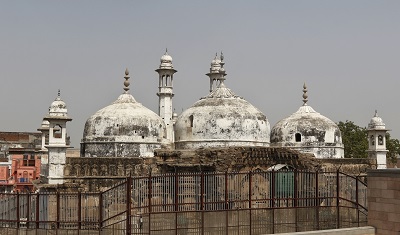Varanasi (UP), (Asian independent) The Gyanvapi mosque management committee, Anjuman Intezamia Masjid (AIM), has termed the Archaeological Survey of India (ASI) report on the scientific study and survey of the mosque as an attempt to “set a false narrative.”
Based on the history available with AIM, it claimed that this mosque was constructed in three phases, starting in the 15th century.
In the first detailed reaction on the ASI survey report, AIM joint secretary S. M. Yaseen said: “A detailed study of the ASI report is being done by legal experts and historians. But, after an initial study of the report, we have reached a conclusion that the facts and findings of the ASI report are not very different from the court commissioner survey conducted in May 2022. In the name of scientific study, a bid has been made to set a false narrative.”
“As per the history available with us, a rich man of Jaunpur, Sheikh Sulemani Mohaddis, had built the mosque on an open land in Gyanvapi between 804-42 Hijri (in the beginning of 15th century). After this, Mughal emperor Akbar initiated expansion of the mosque as per the philosophy of Din-iIlahi and the ruins of western wall are part of the same construction,” he said.
He added that Aurangzeb ensured further expansion in the 17th century. This history is sufficient to make clear that the mosque existed before Aurangzeb, and it was built and expanded in three phases, he said.
Yaseen questioned: “How can it be claimed that it was a grand Hindu temple only?” Varanasi had also been a major centre of Buddhists and after the arrival of Shankaracharya, Buddhists were compelled to migrate from here. It should also be studied whether any Buddhist monastery or temple existed here to know the real history. If the city is excavated, many facts of Buddhists and Jains could also be found.”
Regarding the parts of idols, coins and other objects found by ASI during the survey and deposited under the district magistrate’s custody, Yaseen said: “Before 1993, the area in the vicinity of Gyanvapi was open and it had been converted to a dumping yard. When ASI started the survey, about 10 feet high heap of debris was lying on the mosque’s rear side, while debris up to 3 feet height was noticed in the cellars. The objects were recovered from the same debris, which were dumped near the mosque for decades.”
Despite the Supreme Court’s order for a non-invasive scientific study, the ASI dug up many areas, claimed Yaseen.
He added that GPR can help in indicating the possibility of any structure at any place, but based on the outcomes of studies done through it, claims for a grand Hindu temple are being made.
Confident of getting relief from the SC under the Places of Worship (special provisions) Act, 1991, despite the Allahabad high court rejecting the claims of mosque authorities that Gyanvapi was covered by this Act in 2023, Yaseen said that AIM will not only challenge the ASI report on the Gyanvapi survey but will also keep contesting cases to protect the mosque, wherever they would be filed.








